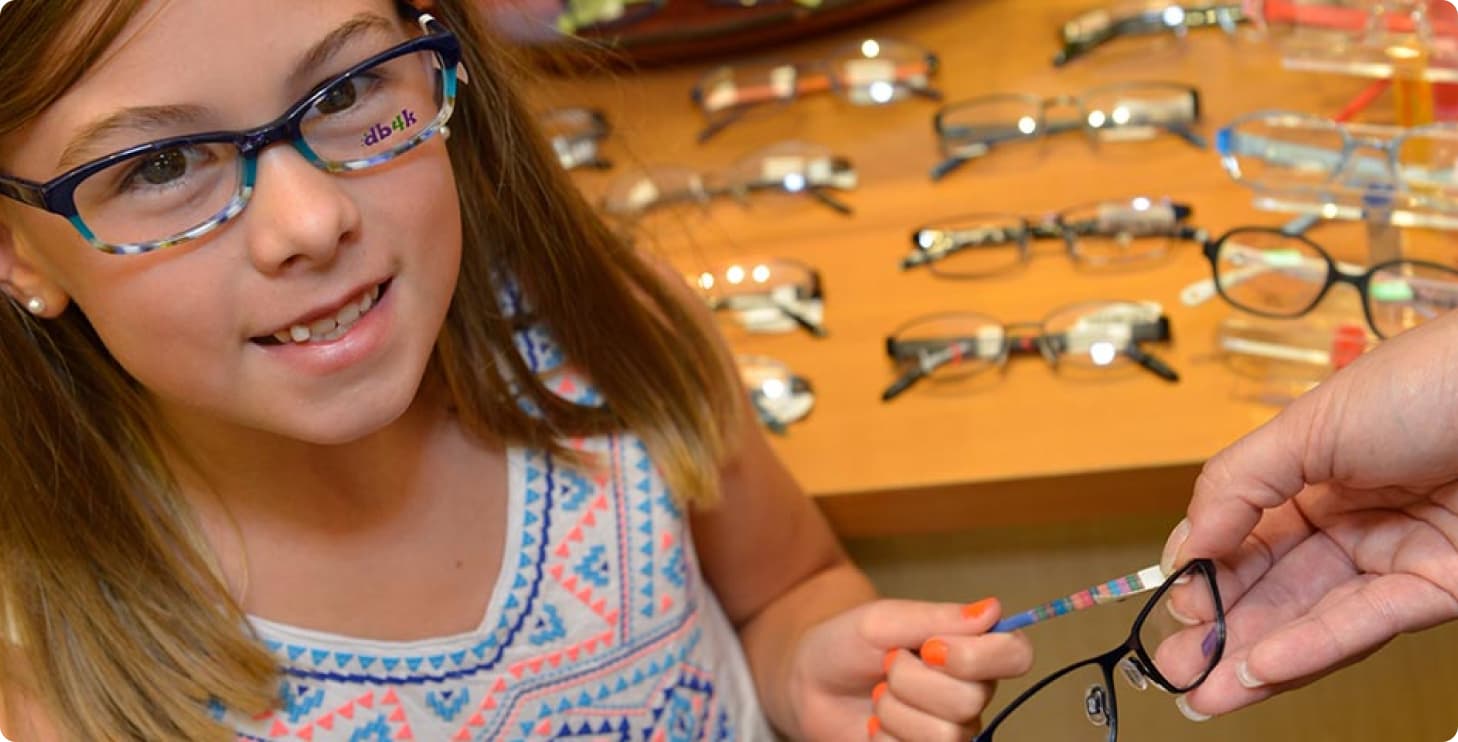A guide to choosing the best eyeglasses for your child
Eyeglasses for children are now fun, colorful, and available in a wide variety of shapes and sizes.
The latest children’s frames are also durable enough to survive the rough and tumble play of today’s child. Also, many well known global brands such as Nike, Adidas, X-Games, Pepe Jeans and Disney are now marketing child-friendly frames.
With all of the appealing choices, walking into an optical store can be quite overwhelming! Remember to keep this experience as fun and relaxed as possible!
Here are some things to keep in mind when going to purchase eyeglasses for your child:
1. Frame size
Eyeglasses frames are now available for children of all ages, even for babies only a few months old. Finding a size that suits your child should be easy— but keep in mind that the optical prescription will determine how thick the lens will be. If your child has a high prescription, avoid large frames —the larger the frame, the thicker the lens will be.
Also, keep in mind that a larger lens means more higher-order aberrations near the edge of the lens, which may mean a higher risk of blurred or distorted peripheral vision.
2. Choose an attractive design
Many kids will feel uneasy wearing glasses for the first time. Let your child show you what they like, while encouraging them to choose frames that have a modern, attractive design. Your child will gain confidence from your approval of their choice of frames, but will also appreciate your opinion.
The goal is for your child to walk out of the store feeling confident and looking good!
3. Metal or plastic?
Nowadays, metal and plastic frames are made similarly in regards to their durability, weight, and cost. However, the metal composition can vary between frames— so it is important to consult with the optical dispenser before deciding on the winning pair.
Also, if your child has shown signs of an allergy to any substance (i.e. nickel) found in many eyeglass frames, don’t worry— there are frames made of hypoallergenic materials available on the market as well.
4. Appropriate bridge fit
Children’s noses are not fully developed so they don’t have a bridge to keep their glasses from sliding down. Finding the right frames for your child can be difficult in this regard.
However, the good news is that metal frames are made with adjustable nose pads, and recently, even plastic frames are being made to fit small noses. With the range of designs available and the advice from an optical dispenser, the frame you choose will fit your child’s nose perfectly.
5. Temple style
If you are concerned about your child’s glasses falling off their face, then you can purchase eyeglasses with cable temples. These temples wrap all the way around the back of the ear and will hold the glasses in place.
Elastic straps that wrap around the back of the child’s head can also be purchased to hold the glasses in place. Both of these options are recommended for younger children. Regular-sized and shaped temples are also available for older children.
6. Spring hinges
Spring hinges allow the temples to flex outward, without causing any damage. Since kids aren’t always careful when they put on and take off their glasses, spring hinges will help to prevent frequent trips to the optical store to adjust or repair frames.
They are also a great feature to have if your child frequently falls asleep with his glasses on. Spring hinges also are especially recommended for toddlers, who very often play with their new glasses.
7. Lens material
Once you and your child agree on frames, the next consideration is the lens material. Children’s lenses should be made of polycarbonate or trivex, both high-index lenses, which are made to be more comfortable than regular plastic lenses. These lenses are lightweight, impact-resistant, and scratch resistant. They also offer UV protection to ensure that young eyes are protected against the sun’s UV rays.
Avoid choosing glass lenses for children’s eyeglasses since they are heavy and can crack or break more easily.
Contact an eye doctor near you to discuss glasses options for your child.
SEE RELATED: Why Does My Child Need Bifocals?
8. Sunglasses
It is important for children to wear sunglasses from a young age to protect their eyes from the sun’s harmful ultraviolet (UV) and high energy visible (HEV) blue light radiation.
Kids spend hours outdoors in the sun— special protection from the sun’s rays especially on the beach, or during snow activities where the sun reflects off of the water and snow, is critical for ocular health! Many experts say that long term exposure to harmful rays can cause severe ocular conditions later in life.
When choosing a pair of shades, keep in mind that while the color and tint density of the lens is typically a matter of personal preference, it is important to ask the optical dispenser if the lenses pass the FDA compliance for safety and UV protection. Also, it is generally beneficial to purchase polycarbonate sunglass lenses for their lightweight, impact-resistant, and comfortable wear.
9. Photochromic/ Transition lenses
If your child needs full-time vision correction, specifically for distance vision, think about purchasing photochromic lenses. Eyeglasses with photochromic lenses, also called transition lenses, are a great option for children because they eliminate the need for sunglasses.
Photochromic lenses automatically change from clear lenses to darkened lenses in the presence of sunlight and then back again to the clear lens when inside. Photochromic lenses come in many different lens materials and colors, and block 100 percent of the sun’s UV rays while providing efficient protection from HEV light.
10. Protective eyewear for sports
Children are vulnerable to eye injuries and broken glasses because they are involved in active play and sports on a regular basis.
If your child is involved in sports, protective eyewear such as sports goggles, wrap-around polycarbonate lenses, or side shields can prevent many sports-related eye injuries and/or damage to their regular eyeglasses.
You may have seen basketball players wearing these types of frames. Protective eyewear is essential for all sports such as hockey, basketball, football, soccer, baseball, tennis, and any other sport where the athlete is in motion. Regular eyeglass frames will not provide enough protection and can easily be damaged. Protective eyewear can be purchased with prescription lenses so children can see clearly while playing their favorite sport, without the risk of getting injured.
11. Warranties
Many optical retailers offer a warranty plan that will replace eye wear at no charge or for a small fee in case of damage to the frames or lenses. Consider opting for the warranty, especially if your child is a toddler, or is wearing glasses for the first time.
12. Purchase a spare pair
Because children can be tough on their glasses, it’s a good idea to purchase a second pair for them, especially if your child has a high prescription and cannot function without his or her glasses.
13. Contact lenses
Don’t forget that contact lenses can also be a great option for your child. Contacts can be worn full-time or as a substitute for glasses. Contact lenses are generally worn during sports, exercise, social events, or when a child simply wants a break from their glasses.
Choosing the most appropriate eyeglasses for your child is your top priority, use this guide to help you in the process— and don’t forget—your child will remember this experience, so have fun!
LEARN MORE: Guide to Children’s Eye Exams
Schedule an eye exam with an eye doctor to help your child see their best.









